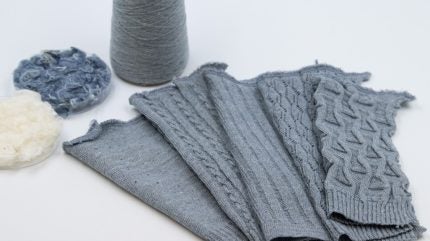
The public Telavalue research project at VTT Technical Research Centre of Finland sees textile recycling as a massive opportunity for the whole of Europe.
It explains recycling technology is advancing rapidly, but a lack of regulation and challenges relating to the composition of waste materials are hindering a real breakthrough.

Discover B2B Marketing That Performs
Combine business intelligence and editorial excellence to reach engaged professionals across 36 leading media platforms.
But, it adds that there is the potential for a billion-dollar business with hundreds of plants across Europe.
Europe’s textile recycling and fashion supply chain potential
Research Professor Ali Harlin shares: “In Europe alone, around 10bn kilograms of textile waste are discarded annually. Textile fibre’s price per kilogram ranges between €2 ($2.33) and €3, so this field offers enormous business potential.”
As it stands, 1% of the world’s textiles are recycled back into textiles with Harlin noting the recycling challenges are mainly due to the complexity of textile raw materials and a lack of regulation.
He adds: “The EU is a global leader in textile recycling regulation, but even here, progress has been slow. Proper regulation needs to be in place before we can expect significant advancements in textile recycling rates.”

US Tariffs are shifting - will you react or anticipate?
Don’t let policy changes catch you off guard. Stay proactive with real-time data and expert analysis.
By GlobalDataThe EU has been working on a revision to its Waste Framework Directive, which will bring the textile sector under the so-called Extended Producer Responsibility (EPR). This means textile companies themselves would be responsible for organising textile recycling.
Harlin believes once recycling increases it could bring parts of the textile production chain back to Europe.
Strong technology development currently takes place in Northern and Western Europe and manufacturing expertise sits mainly in Eastern and Southern Europe. This means a functioning European textile recycling ecosystem requires European cooperation.
He clarifies: “Individual countries are too small to act alone. Europe could see the rise of five to ten chemical recycling plants. To feed one chemical plant with textile raw material, we need approximately 10 mechanical fibre plants.”
Finland aims to solve textile’s waste and recycling challenges
In Finland a network of textile companies and research institutions completed a ten-year project last year, which was designed to solve the sustainability and waste challenges associated with the textile industry.
The project’s main scientist Pirjo Heikkilä explains: “If a textile can no longer be repaired or reused, the preferred option is mechanical fibre recycling, where collected and sorted textile waste is opened by shredding the fabric and yarn structure into fibres that can be reused in textile production.
“When the waste is heavily worn or of low quality, it makes sense to move towards chemical recycling, where fibres are broken down and rebuilt at the polymer and even monomer level.”
Harlin adds that used textiles can be made into not only new textiles but also nonwoven fabrics, wind turbine blades and vehicle sound insulation.
The research project describes the popularity of price-cutting ultra-fast fashion as a major problem for textile recycling. It notes low-quality and mixed composition textiles are difficult to recycle profitably.
But, it states the workwear sector is already in a more favourable situation.
Heikkilä says: “Workwear is mainly purchased as a service, which means that the quality, maintenance, washing, and repair of the clothes are in order. Textiles are used for as long as possible, and the business model encourages the use of durable, high-quality materials. When a garment reaches the end of its lifecycle, recycling back to textiles is easier because the materials of the textiles are well known.”
Senior Scientist Eetta Saarimäki points out that not all complex textile structures and blended materials can be recycled into new textiles.
However, she says: “Through thermo-mechanical recycling, these materials can be used to produce composite products, giving them a new life one more time.”





